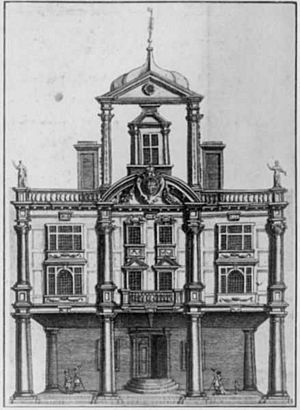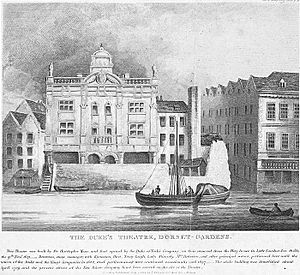Dorset Garden Theatre facts for kids
The Dorset Garden Theatre was a famous theatre in London, built in 1671. When it first opened, it was also known as the Duke of York's Theatre or the Duke's Theatre. This was because James II, who was then the Duke of York, supported the theatre company that performed there.
In 1685, King Charles II passed away. His brother, the Duke of York, became King James II. When he became king, the theatre's name changed to the Queen's Theatre. This new name honored James's second wife, Mary of Modena. The name stayed the same even when William III and Mary II became rulers in 1689.
This theatre was the fourth home for the Duke's Company. This was one of only two special theatre companies allowed to perform in London after the king returned to power. After 1682, another company called the United Company also used it. The theatre was eventually taken down in 1709.
Contents
How the Theatre Came to Be
After a long time when theatre was not allowed in England, performances were finally permitted again. This happened when King Charles II returned to the throne. He gave special permission, called "Letters Patent," to two theatre companies. These companies were allowed to perform "legitimate drama" in London.
The Duke's Company was supported by the Duke of York. The other company, the King's Company, was supported by King Charles II himself. Both companies started in an old theatre called the Cockpit Theatre. Then, the Duke's Company moved to the Salisbury Court Theatre for a short time.
In 1662, the Duke's Company found a new home at Lincoln's Inn Fields. They performed there until 1671. Meanwhile, the King's Company moved to the Theatre Royal, Drury Lane and stayed there.
Building a New Home
The person who started the Duke's Company was Sir William Davenant. He was also a famous writer. Davenant loved new stage designs and machines that could change the scenery. He helped bring these exciting new ideas to English theatre. Sadly, he died before the Dorset Garden Theatre started being built in 1670.
So, the Davenant family, along with a top actor named Thomas Betterton, oversaw the building. The people who owned shares in the company agreed to raise money. They collected about £9,000, which was a huge amount back then! They rented the land in Dorset Garden until 1709.
Just before the theatre opened, Thomas Betterton traveled to France. People believe he went to see the newest French stage technology. He wanted to bring these ideas back to England. After he returned, the Dorset Garden Theatre put on many amazing shows. These included big opera versions of William Shakespeare's Macbeth (1673) and The Tempest (1674).
These shows were called "Restoration spectaculars." They used changeable scenery and machines to move actors and objects. They also featured lots of music, dancing, and large groups of performers.
The Theatre Building
The Dorset Garden Theatre was built where an old house, Dorset House, used to be. This house was destroyed in the Great Fire of London. The area then became filled with many new buildings. The theatre was located right by the Thames River. This was great because people could travel to the theatre by boat. This helped them avoid a nearby area that was known for crime.
The theatre opened on November 9, 1671. It was almost twice as big as the Duke's Company's old theatre. It became the most important playhouse in London when the Theatre Royal burned down in January 1672. However, a new Theatre Royal opened in 1674 and became a rival.
After the Duke's Company joined with the King's Company in 1682, the Dorset Garden Theatre was mostly used for operas, music, and big spectacular shows. In the 1690s, it even hosted other events, like weight lifting! The building was torn down in 1709.
Inside the Theatre
We don't have many old pictures of the inside of the theatre. However, the two theatre companies were rivals. This led to descriptions of the Dorset Garden theatre in poems and writings from that time. These writings give us clues about what the theatre was like.
Thomas Betterton, the famous actor, lived in an apartment on an upper floor of the theatre. Many important people lived nearby too. The writer Aphra Behn lived on Dorset Street. The famous poet John Dryden lived in Salisbury Square. And the philosopher John Locke lived in Dorset Court.
No one knows for sure who designed the theatre building. Some people thought it was Sir Christopher Wren, a very famous architect. But this seems unlikely. Perhaps Robert Hooke, who worked with Wren, had something to do with the design.
The outside of the theatre was about 147 to 148 feet long and 57 feet wide. This included a porch that was 10 feet deep. A visitor in 1676 said it had a central "pit" area, like an amphitheater. It also had two levels of boxes, each holding about twenty people. There was an upper gallery too. The theatre could hold about 850 people. The inside was very fancy, with beautiful carvings by Grinling Gibbons.
The Amazing Stage
The Dorset Garden Theatre had a very large "forestage." This was a part of the stage that stuck out into the audience. It was about 19 feet 6 inches deep and 30 feet 6 inches wide. This large forestage gave actors, singers, and dancers plenty of space to perform. It was also well-lit.
The forestage helped connect the audience to the performers. It felt like an extension of the play's setting. Actors could enter the forestage through special doors, probably two on each side. Above these doors were balconies, which could also be used for acting or for extra seating.
The main scenic stage was probably about 50 feet deep and 30 feet high. The arch that framed the stage, called the "proscenium arch," was likely about 30 feet wide and at least 25 feet high. This was needed to fit the huge scenery used in operas.
Both the forestage and the main stage were "raked." This means they sloped upwards away from the audience. A small area above the proscenium arch could hold 8 to 10 musicians for background music. A full orchestra would sit in the "pit," right in front of the stage.
The Duke's Company was already good at using movable scenery. They used sliding panels that could quickly open or close to show a new scene. But Dorset Garden was even more advanced! It could "fly" at least four people at once. It could also move large objects, like a cloud that covered the whole stage and carried a group of musicians. There were also many trapdoors in the floor.
This theatre was specially designed for staging "Restoration spectaculars." It was the only playhouse in London that could create all the amazing effects these grand shows needed.




